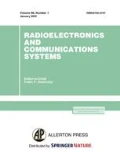Abstract
Frequency scarcity due to demand of bandwidth in wireless communication can be resolved by knowledge of spectrum occupancy. Therefore different measurement campaigns were conducted for spectrum occupancy worldwide. It has been observed that large numbers of bands is underutilized. These bands can be utilized by a secondary user without interference. In this paper, Spectrum utilization has determined by conducting a campaign for measurement of spectrum occupancy in the Solapur city, India for 0.7 to 2.4 GHz frequency region. As per the analysis, Telecom cellular service band has highest spectrum occupancy while aeronautical radio, fixed satellite doesn’t have any utilization. Total average spectrum occupancy is 15.77%. These results are obtained by using circularly polarized wideband microstrip antenna in place of commercially available antennas for measurement campaign, which shows good agreement with occupancy results but with lower system complexity. The results propose that Solapur city would be a better choice for deployment of cognitive radio as emerging technology to share the unoccupied spectrum.
Similar content being viewed by others
References
“FCC on Line Table of Frequency Allocations,” Federal Communications Commission, Office of Engineering and Technology Rules and Policy Division. Revised on August 31, 2016.
M. Wellens, J. Wu, P. Mahonen, “Evaluation of spectrum occupancy in indoor and outdoor scenario in the context of cognitive radio,” Proc. of 2nd Int. Conf. on Cognitive Radio Oriented Wireless Networks and Communications, CrownCom2007, 1-3 Aug. 2007, Orlando, FL, USA (IEEE, 2007). DOI: 10.1109/CROWNCOM.2007.4549835.
S. S. Shirgan, U. L. Bombale, “A wide axial ratio bandwidth circularly polarized antenna for spectrum occupancy measurement campaign,” Int. J. Future Generation Commun. Networking 10, No. 9, 49 (2017). DOI: 10.14257/ijfgcn.2017.10.9.05.
M. Lopez-Benitez, A. Umbert, F. Casadevall, “Evaluation of spectrum occupancy in Spain for cognitive radio applications,” Proc. of Vehicular Technology Conf., VTC Spring, 26-29 Apr. 2009, Barcelona, Spain (IEEE, 2009). DOI: 10.1109/VETECS.2009.5073544.
V. Valenta, R. Marsalek, G. Baudoin, M. Villegas, M. Suarez, and F. Robert, “Survey on spectrum utilization in Europe: Measurements, analysis and observations,” Proc. of Fifth Int. Conf. on Cognitive Radio Oriented Wireless Networks and Communications, CROWNCOM, 9-11 Jun. 2010, Cannes, France (IEEE, 2010). DOI: 10.4108/ICST.CROWNCOM2010.9220.
R. I. C. Chiang, G. B. Rowe, K. W. Sowerby, “A quantitative analysis of spectral occupancy measurements for cognitive radio,” Proc. of IEEE 65th Vehicular Technology Conf., VTC2007-Spring, 22-25 Apr. 2007, Dublin, Ireland (IEEE, 2007), pp. 3016–3020. DOI: 10.1109/VETECS.2007.618.
Kishor Patil, Knud Skouby, Ashok Chandra, Ramjee Prasad, “Spectrum occupancy statistics in the context of cognitive radio,” Proc. of 14th Int. Symp. on Wireless Personal Multimedia Communications, WPMC, 3-7 Oct. 2011, Brest, France (IEEE, 2011), pp. 486–490. URI: http://ieeexplore.ieee.org/document/6081549/.
M. H. Islam, C. L. Koh, S. W. Oh, X. Qing, Y. Y. Lai, C. Wang, Y.-C. Liang, B. E. Toh, F. Chin, G. L. Tan, W. Toh, “Spectrum survey in Singapore: Occupancy measurements and analyses,” Proc. of 3rd Int. Conf. on Cognitive Radio Oriented Wireless Networks and Communications, CROWNCOM, 15-17 May 2008, Singapore, Singapore (IEEE, 2008). DOI: 10.1109/CROWNCOM.2008.4562457.
M. Lopez-Benitez, F. Casadevall, “Methodological aspects of spectrum occupancy evaluation in the context of cognitive radio,” Proc. of 15th European Wireless Conf., EW2009, 17-20 May 2009, Aalborg, Denmark (IEEE, 2009). DOI: 10.1109/EW.2009.5357973.
T. Yucek, H. Arslan, “A survey of spectrum sensing algorithms for cognitive radio applications,” IEEE Commun. Surveys Tutorials 11, No. 1, 116 (2009). DOI: 10.1109/SURV.2009.090109.
J. Mitola, G. Q. Maguire, “Cognitive radio: making software radios more personal,” IEEE Personal Commun. 6, No. 4, 13 (1999). DOI: 10.1109/98.788210.
Liang Yin, S. Yin, Weijun Hong, Shufang Li, “Spectrum behavior learning in cognitive radio based on artificial neural network,” Proc. of Military Commun. Conf., 7-10 Nov. 2011, Baltimore, MD, USA (IEEE, 2011). DOI: 10.1109/MILCOM.2011.6127671.
International Telecommunication Union (ITU), Radio Communication Bureau, “Handbook Spectrum Monitoring”, 2011.
National Frequency Allocation Plan NFAP-2011.
Author information
Authors and Affiliations
Corresponding author
Additional information
Original Russian Text © S. Shirgan, U. Bombale, 2018, published in Izvestiya Vysshikh Uchebnykh Zavedenii, Radioelektronika, 2018, Vol. 61, No. 2, pp. 73–84.
About this article
Cite this article
Shirgan, S., Bombale, U. Analysis of Wideband Microstrip Antenna based Spectrum Occupancy Measurement Campaign for Cognitive Radio Application. Radioelectron.Commun.Syst. 61, 55–63 (2018). https://doi.org/10.3103/S0735272718020024
Revised:
Published:
Issue Date:
DOI: https://doi.org/10.3103/S0735272718020024




